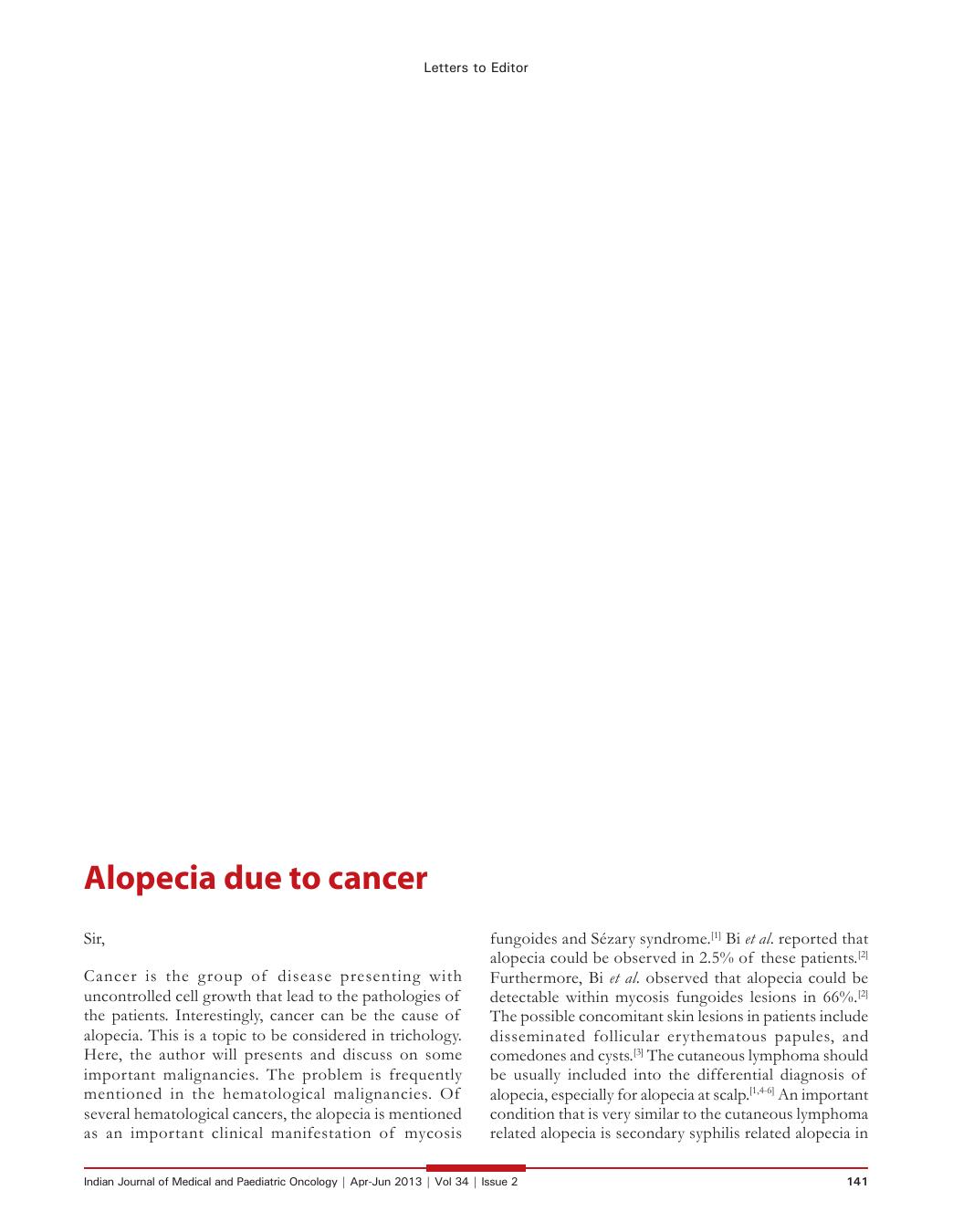Alopecia due to cancer
CC BY-NC-ND 4.0 · Indian J Med Paediatr Oncol 2013; 34(02): 141-142
DOI: DOI: 10.4103/0971-5851.116228

Publication History
Article published online:
20 July 2021
© 2013. Indian Society of Medical and Paediatric Oncology. This is an open access article published by Thieme under the terms of the Creative Commons Attribution-NonDerivative-NonCommercial-License, permitting copying and reproduction so long as the original work is given appropriate credit. Contents may not be used for commercial purposes, or adapted, remixed, transformed or built upon. (https://creativecommons.org/licenses/by-nc-nd/4.0/.)
Thieme Medical and Scientific Publishers Pvt. Ltd.
A-12, 2nd Floor, Sector 2, Noida-201301 UP, India
Sir,
Cancer is the group of disease presenting with uncontrolled cell growth that lead to the pathologies of the patients. Interestingly, cancer can be the cause of alopecia. This is a topic to be considered in trichology. Here, the author will presents and discuss on some important malignancies. The problem is frequently mentioned in the hematological malignancies. Of several hematological cancers, the alopecia is mentioned as an important clinical manifestation of mycosis fungoides and Sézary syndrome.[1] Bi et al. reported that alopecia could be observed in 2.5% of these patients.[2] Furthermore, Bi et al. observed that alopecia could be detectable within mycosis fungoides lesions in 66%.[2] The possible concomitant skin lesions in patients include disseminated follicular erythematous papules, and comedones and cysts.[3] The cutaneous lymphoma should be usually included into the differential diagnosis of alopecia, especially for alopecia at scalp.[1,4,5,6] An important condition that is very similar to the cutaneous lymphoma related alopecia is secondary syphilis related alopecia in human immunodeficiency virus infected patients.[7] In addition to lymphoma, alopecia is also mentioned in plasmacytoma.[8] Alopecia is an important component in paraneoplastic syndrome due to plasmacytoma.[8,9] In addition to hematologic malignancies, the solid cancers can also cause alopecia. Alopecia might be induced by tumor metastasis to the scalp.[10] The common underlying source of metastasis is breast cancer in female.[10] The other uncommon solid tumor that can cause alopecia is adenoma.[11] The mechanism is due to the hyperandrogenemia.[11]
However, the more well-known cancer-related alopecia is the side-effect of cancer therapy. It is no doubt that chemotherapy can induce alopecia. This problem can be seen in three-fifths of the patients undergoing chemotherapy.[12] The pathological changes of hair include trichorrhexis, fragmentation, decreased hair diameter, and hair shaft depigmentation.[12] Focusing on the natural history, the problem usually occurs after the 1st or the 2nd cycle of administration of therapeutic regimen (about 1 week to 2 months after the start of cancer therapy).[12] More numbers of used chemotherapeutic agents result in more severe alopecia.[12] For reducing the problem, immunomodulator drugs, both modern and herbal regiment seems to be useful in the management of this problem.[12] Furthermore, the poor nutritional status increases the risk of alopecia, hence the improvement of nutrition for patients receiving chemotherapy can be a good preventive method for this problem.[13]


 PDF
PDF  Views
Views  Share
Share

